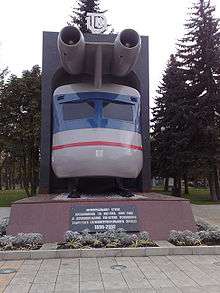Turbojet train

A turbojet train is a train powered by turbojet engines. Like a jet aircraft, but unlike a gas turbine locomotive, the train is propelled by the jet thrust of the engines, rather than by its wheels. Only a handful of jet-powered trains have been built, for experimental research in high-speed rail.
Turbojet engines have been built with the engine incorporated into a railcar combining both propulsion and passenger accommodation rather than as separate locomotives hauling passenger coaches.
Turbojet engines are most efficient at high speeds[note 1] and so they have been applied to high-speed passenger services, rather than freight.
M-497
The first attempt to use turbojet engines on a railroad was made by the New York Central Railroad in 1966. Their railcar M-497 was able to reach speeds up to 184 miles per hour (296 km/h).[1][2]
LIMRV
_IS_TESTED_AT_THE_DEPARTMENT_OF_TRANSPORTATION'S_HIGH_SPEED_GROUND..._-_NARA_-_545956.jpg)
Speed was limited due to the length of track (6.4 mi or 10.3 km) and vehicle acceleration rates. Two Pratt & Whitney J52 jet engines were added to the vehicle to propel the vehicle up to higher speeds, after acceleration the engines were then throttled back so that the thrust equaled their drag.
On 14 August 1974, the LIMRV achieved a world record speed of 255.7 mph (411.5 km/h) for vehicles on conventional rail.[3] [4] [5]
SVL

Another turbojet railcar, SVL (High-speed Laboratory Railcar), was built in the USSR in 1970.[6] The SVL was able to reach a speed of 250 kilometres per hour (160 mph).[7][8] This locomotive was built on a basis of the main engine railcar of ER22 electric multiple unit. It had a mass of 54.4 tonnes (including 7.4 tonnes of fuel) and was 28 metres (92 ft) long. The power car was planned to be used as a part of "Russian troika" express.[7] In 2014 the train still existed, but in a derelict state.[9]
See also
- A contemporary French hovercraft train, also powered by a jet engine
- A German propeller-driven railcar of 1929
Notes
- ↑ Their efficiency increases as vehicle speed increases to the speed of the exhaust jet, although this is considerably more than railway speeds.
References
- ↑ "It's a Jet! It's a Train! It's M-497". Dark Roasted Blend: Weird and Wonderful Things. 2007-01-12. Retrieved 2008-03-21.
- ↑ Wojdyla, Ben (2008-02-21). "Retro: New York Central's M-497 Jet Powered Train". Jalopnik.com. Retrieved 2008-03-21.
- ↑ Johnson, R. D. (1988). "Thoughts at 160 mph". Proceedings of the American Railway Engineering Association. 89: 330–331. Retrieved 2010-09-11.
- ↑ Reiff, Glenn A. (1973). "New Capabilities in Railroad Testing". Proceedings of the American Railway Engineering Association. 74: 1–10. Retrieved 2010-09-11.
- ↑ "The Rohr Aerotrain Tracked Air-Cushion Vehicle (TACV)". SHONNER Studios. Retrieved 2010-08-28.
- ↑ "Турбореактивный вагон СВЛ (Turbojet engine SVL)" (in Russian). Retrieved 2008-04-08.
- 1 2 "Flying on rails". Pravda. 1972-03-17.
- ↑ "Soviet Jet Train. Some More History.". English Russia. 23 May 2007.
- ↑ "Abandoned and Rusty Soviet Turbo Jet Train". English Russia. 26 May 2014.
